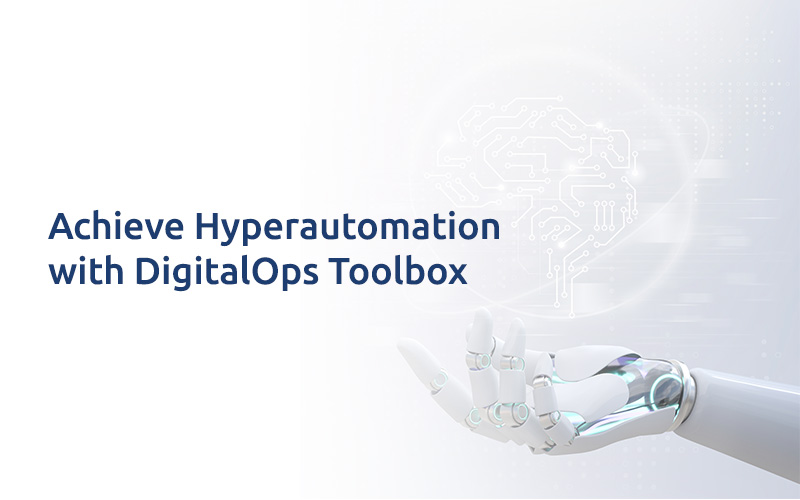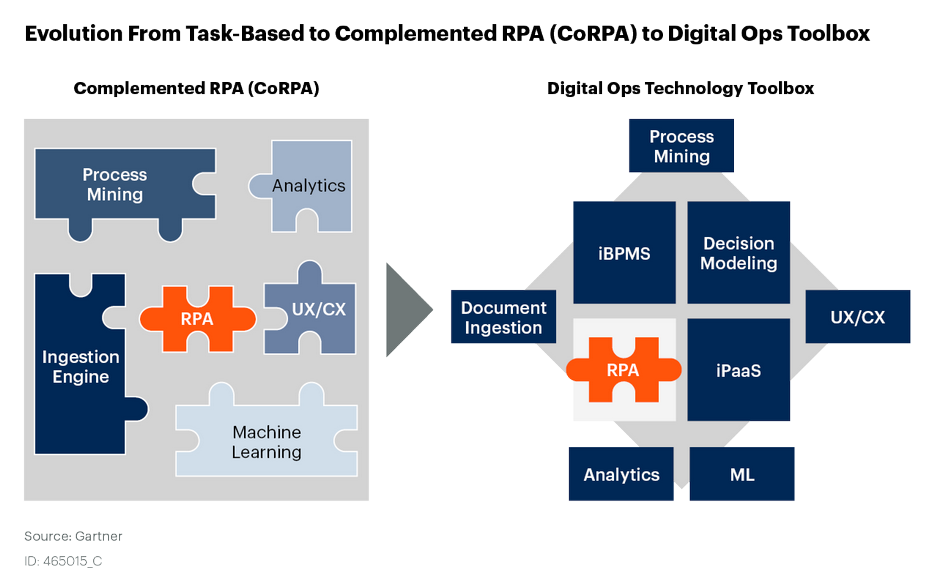
Achieve Hyperautomation with DigitalOps Toolbox
Hyperautomation is the process of bringing together several components of process automation, integrating tools and technologies that amplify the ability to automate work. It starts with robotic process automation (RPA) at its core, and expands automation capability with artificial intelligence (AI), process mining, analytics, and process silos to automate and augment business processes. The idea is to automate more and more knowledge work, and engage everyone in an organization to be part of the transformation. Gartner has named hyperautomation among the top 10 strategic trends for 2020.
Hyperautomation can be enabled by DigitalOps — which is a business process framework designed to simplify, measure and manage processes across the enterprise. The DigitalOps toolbox offers a wide array of technologies beyond RPA, such as BPM, workflow engines, decision management suites, process mining, low-code application platforms (LCAPs) and others. However, the most common question raised by Enterprise Architecture and technology innovation leaders is where to start so that they can capitalize on DigitalOps competencies and tools.
The research done by Gartner answers this question, this solution includes three steps which are,
Define an automation journey.
A roadmap is a very important first step. It is important to lay out the desired business outcome and the processes that need to be optimized, before automating and assembling tools from the DigitalOps toolbox.
Co-create a strategy to combine DigitalOps tools.
A DigitalOps toolbox that is aligned to business model driven process automation comes with many options to address the different steps of process automation. The company should inspect cases and their long-term business objectives to identify the optimal combinations of these tools.
Augment business processes with AI.
To accelerate hyperautomation, an integrated system of intelligence effectively combines DigitalOps tools with Artificial intelligence (AI), Machine learning (ML), Natural language processing (NLP), Optical character recognition (OCR), Conversational chatbots.
In this article, DigitalOps tools and strategies to combine them will be discussed in detail.
RPA, it is a noninvasive integration technology used to automate routine, repetitive and predictable tasks through orchestrated UI interactions that emulate human actions.
RPA can be used to focus on the following:
- Delivering quick wins by automating routine and repetitive tasks.
- Creating API facades with legacy applications. Use the noninvasive means of RPA to interact with legacy applications where building traditional integration will be complex, time-consuming and expensive.
- Transporting, consolidating and validating data from disparate sources in a large-scale ERP migration project.
Process mining is designed to discover, monitor and improve real processes by extracting knowledge from the event logs readily available in application systems.
Process mining tool can be used to:
- Identify process inefficiencies at a granular level.
- Discover, monitor and configure tasks that can be automated by bots/scripts.
- Extract knowledge from events readily available on a workstation or captured from screens.
- Create process documentation and auto generation of simulation models.
Intelligent BPM suites (iBPMS) have a solid foundation of tools for orchestrating processes and automating tasks within those processes. iBPMS consolidate integration services, decision management, process orchestration, ad hoc processes and advanced analytics into a single platform.
BPM tool helps you focus on the following:
- Managing long-lived and cross-organization business processes that span people, machine services and things, as well as functional boundaries.
- Applying iBPMS as a master orchestrator of process and managing task lists.
- Triggering an RPA bot/script to automate a task within a process. You may use APIs to integrate the RPA scripts with your BPM master orchestrator.
- Monitoring metrics and creating analytics dashboards to identify opportunities to improve the process.
Low-Code Application Platforms
The graphical nature of LCAP development environments can be used for modelling rapid automation of a business process. Most LCAP vendors offer business process orchestration and workflow services to rapidly automate tasks and orchestrate them into simpler processes.
LCAP can be applied as a complementary tool to focus on the following:
- Automating a process that is small in scope, or changes frequently and is constrained to a single business function or team.
- Exploiting the broad set of connectors to automate tasks related to applications that have existing APIs.
Decision Management Suites (DMSs)/Business Rules Management Systems (BRMSs)
DMSs are used to supplement conventional application development and runtime tools when a business application includes decisions that entail complicated or frequently changing logic. Modern DMS products have evolved beyond business rule management systems by providing better support for analytics and decision modeling. These can be used alongside BPM tools.
A DMS is relevant for decision-centric applications that involve any of the following:
- Diverse kinds of input data, which may be collected from multiple sources
- Multiple calculations
- Dozens, hundreds or thousands of business policies, implemented as rules
- Sophisticated algorithms that involve a mix of rules and analytics models
- Multiple stakeholders, sometimes with different objectives

